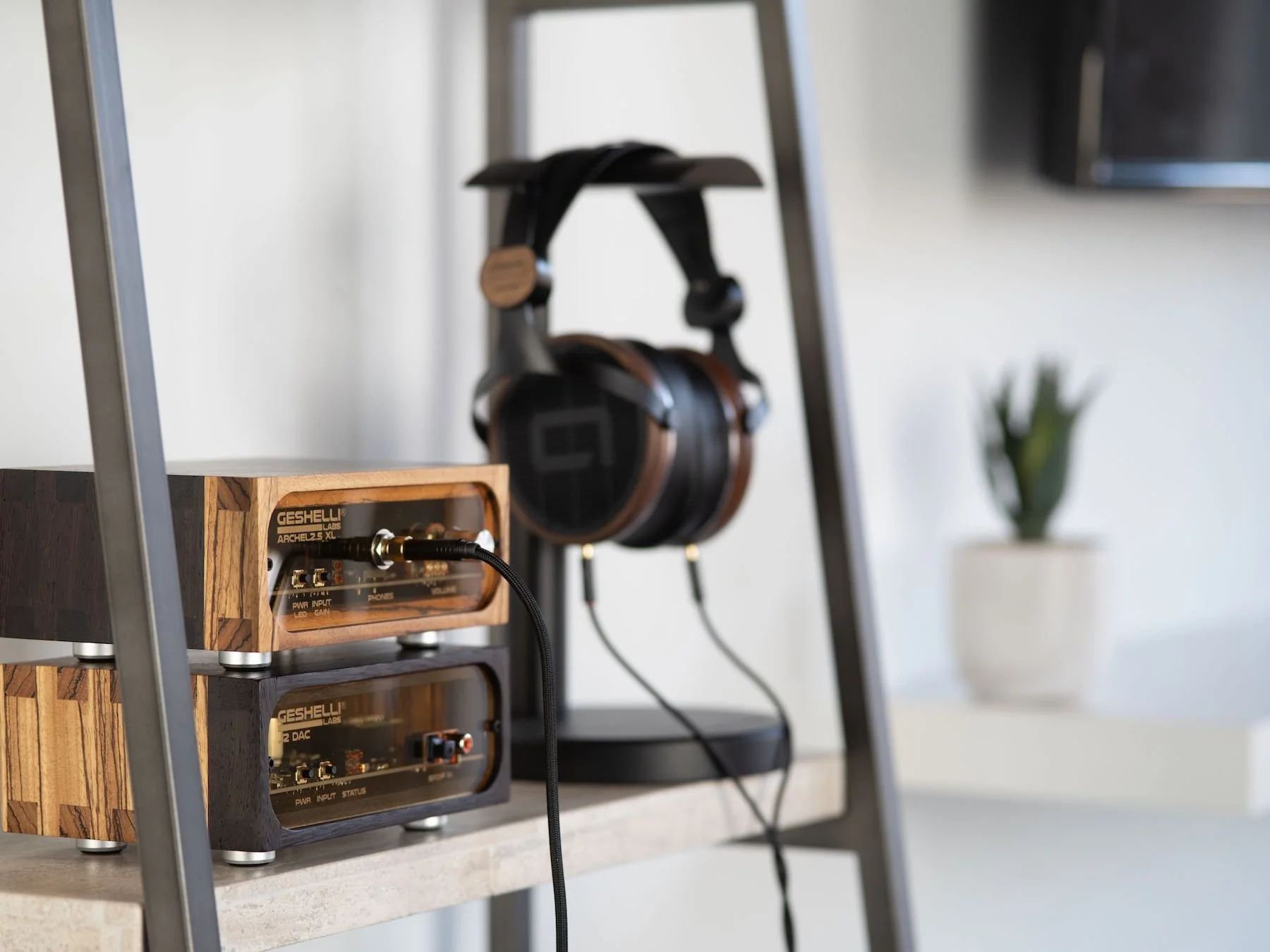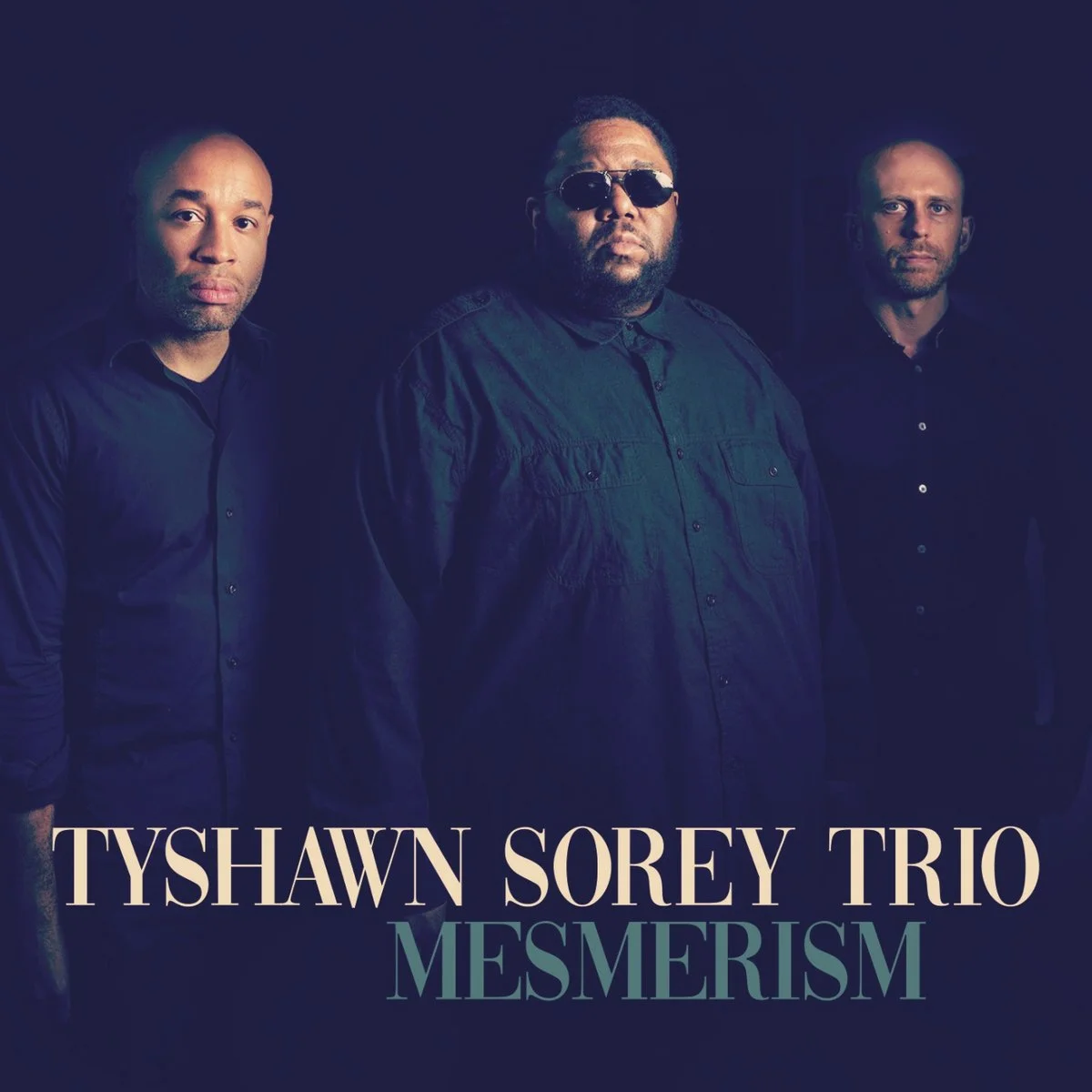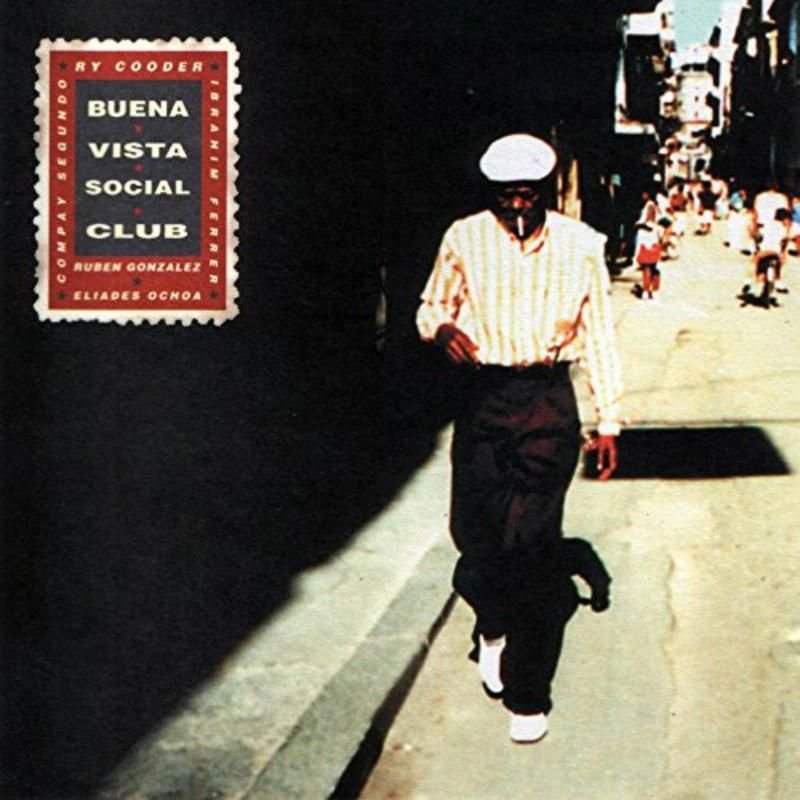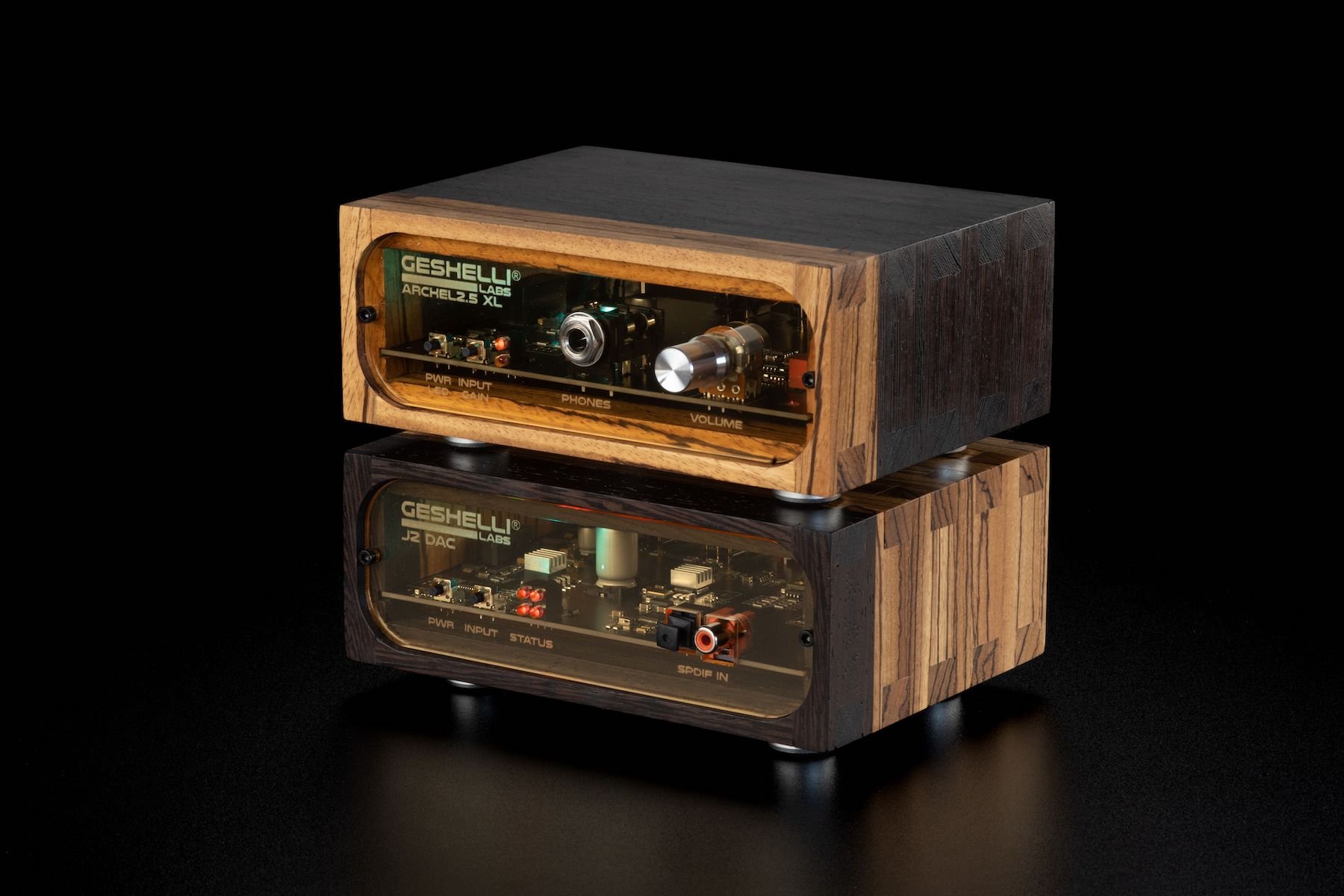GESHELLI LABS E2/J2 - REVIEW
GESHELLI LABS
The world of personal audio has moved in many directions since John C. Koss and Martin Lange invented the stereo headphone in 1958. Most of those changes have improved sound quality while making our listening more convenient as well. Bluetooth and other wireless technologies certainly have made music consumption easy and mostly thoughtless, though there are those who still strive for better fidelity. In pursuit of a more nuanced audio experience, we tweakophiles opt for wired ear or headphones and, to bring the electronics within arms length, savvy shoppers choose balanced cabling between source and amp. Toward that end, I bring you the killer combo of the $250 Geshelli JNOG2 digital–to–analog converter (DAC) and the fully balanced $220 ERISH2 headphone amplifier.
Geshelli Labs is a private, woman–owned company based in Florida, with three generations of the Geshelli family contributing to the enterprise. Product names all relate to family members. When asked for a backgrounder, Sherri Geshelli told me that she and Geno started the company in their house. “When Geno was young, he always dreamed of owning nice audio systems like he would see in magazines. In 2016, Geno decided to try to make his own DAC…He worked on it for months before he was ready to show me. I was blown away when I heard it and encouraged him to make another to sell.” Hand soldered, in a plexi enclosure, a buyer loved it and told his friends. Initially assembling in their dining room, by 2018 they “…were busy enough to rent a garage with no air conditioning next to the train tracks. It was hot and loud but we were determined to make our company succeed.” Fast forward to today, where they are “…in a nice building, (with) two stencil printers, two full PCB assembly lines complete with reflow ovens, a wood shop, a powder coating shop and enough business to be able to hire both our kids and Geno’s dad. Geshelli is a true family operation.”
To keep costs down, the ERISH2 is opamp–based. Fancy operational amplifiers are built from discrete parts, and will run you around $40 per channel. Modern integrated “chip” opamps are excellent performers, and most cost a fraction of what you’d have to lay out for an equivalent discrete amp. The ERISH2 uses two $6 OPA1612 chip amps along with four single channel buffers. All four channels, two each for left and right, are handled independently to achieve maximum signal–to–noise ratio (SNR) and minimum distortion + noise specs (THD+N), “basically at the limits of the opamps,” Sherri Geshelli told me. The ERISH2 develops a hefty 2 Watts of power per channel, enough to cleanly drive even difficult loads.
Buyers have a wide choice of case and front/back color. You also get to choose the DAC chip; AKM’s AK4493; the SABRE ES9026PRO or ES9038Q2M. As delivered, the JNOG2 I tested employs ESS Technology’s fancy SABRE ES9038Q2M 2 channel monolithic DAC chip with the $50 additional Amanero USB input module. These days, I largely rely on USB rather than an AES/EBU digital input. The JNOG2 comes standard with AES-3 unbalanced and optical inputs. Before The Fire‡, Geshelli exclusively used AKM. To their ears, AKM chips are the most neutral and colorless they have found. After The Fire with AKM parts unavailable, Geno redesigned the DAC with the ES9026PRO, then the ES9038Q2M. Once AKM availability eased, he redesigned the layout for AKM again so customers now have a choice of sound signature or lack thereof. Geno tries very hard not to allow any “house sound” to weasel its way into the product.
Remember I mentioned “four channels”? One of the many things I love about the Geshelli combo is the balanced interconnect; two conductor sets for each channel. This allows you to park the DAC at the end of that very short USB cable you have while keeping the amp nearby. You <em>did</em> purchase a minimum–length USB interconnect, didn’t you? Next to the appallingly poor jitter performance of a POF (Plastic Optical Fibre) TOSLINK cable, USB is stellar but that don’t mean it’s robust. Like me, good things come in short packages and passive USB cables should be kept as short as possible to maintain solid signaling integrity. Okay, back to balanced analog…Since a DAC usually stays snuggled up to your digital source via that minimal length USB connection, it’s noice to have your headphone amp close to your comfy listening chair. A balanced connection is far more immune to induced radio frequency noise that an unbalanced link, which means a 15 foot run of high quality wire won’t incur significant high frequency loss or noise pickup. Another aspect I enjoy is the look. Cosmetics are important; nobody wants an ugly box polluting their living space, and the Geshelli combo has a fun, cozy aesthetic, with their dovetailed cabinetry and peekaboo front and rear fascia for the wood option. A young adult visitor to our darkened living room specifically gushed about the magenta internal illumination I had chosen…Oh, didn’t I mention? Both units have six user selectable colors plus off and white visible through the clear acrylic fascia option; mix or match mood lighting between your DAC and amp.
To begin my listening tests, I chose the one headphone I had that included a ⅛" unbalanced TRRS plus an XLR-4 balanced cable set; Meze’s fantastic Empyrean. At $3k, this is more than a bit of a price mismatch but at least the cans were not the weakest link in the testing chain. Once that choice was made, I performed a quick sanity check: does the Geshelli combo outperform my MacBook M1 Air’s headphone jack? Yes it did. In terms of bandwidth, clarity and midbass solidarity, the Geshellis won. Now it was time to muck about in the weeds…
To get a better sense of the Geshelli fingerprint, I needed to divorce the electronics from the transducers. As it turns out, the Empyrean shares a connector configuration with my $2k Audeze LCD-3, another planar magnetic, circumaural design. Because of that, I could jump back and forth between the very flat, brutally honest character of the LCDs, and the fuller, more romantic rendition that the Empyrean offers. On Tyshawn Sorey’s album Mesmerism [Qobuz 96k], he steps away from his regular knack for exceptional composition to uniquely explore other writer’s work. His version of the 1948 Ellis/Frigo/Carter standard, Detour Ahead, displays Sorey’s spare and tasteful drumming as it propels Aaron Diehl’s keys and Matt Brewer’s bass to a calming, contemplative conclusion. Via a well–defined, realistic soundstage, the Geshelli combo transmited not only each instrument’s timbral contribution, but the intimate and completely plausible acoustic space created by engineer Aaron Nevezie. No piano the size of Newark here, folks!
At about the same price as Geshelli’s JNOG2 is Clarus Cable’s CODA, a DAC and HPA tucked into a rectilinear extruded aluminum case the length of a lipstick. The CODA is my favorite dongle–style converter/amp to convey an honest portrait of the input data stream when compared to TXH’s Onyx and AudioQuest’s DragonFly Cobalt. The Onyx is dry while the Cobalt wears rose, not cobalt–colored glasses. When played against each other, the Geshelli combo consistently delivered a more spacious soundstage with a better balanced tonal character. Of course, you’d expect more from two mains–powered separates and you’d be justified. The Geshelli dropped me into the room that the Buena Vista Social Club band were playing in on the 2021 re–release of their pioneering acoustic Latin jazz album [Qobuz 96k]. On the third cut, El Cuarto de Tula, listen to the room microphone pickup of horns and percussion. There’s a short slap echo and beautiful liveness that close mic’ing would not capture.
The evocative motion picture soundtrack for Where The Crawdads Sing [48k Qobuz] sent me into a wistful funk, picturing bygone green afternoons and evening cricket choruses in the Appalachian Mountains. The album was recorded on the Newman scoring stage at 20th Century Fox Film Studios, according to Stephen Marsh, the project’s mastering engineer. Marsh mentioned via email that the “…Atmos (version) should be up any day now,” but I listened to the stereo mix. The bluegrass–inspired cue titled “Mussels For Jumpin’,” though clearly synthesized in post from mostly close mic’d tracks, still painted a warm, charming and convincing portrait through both the Empyrean and LCD-3 headphones. Thanks to the Geshelli pairing, the many stringed instruments all sat in the mix without becoming a tangle, and the pick sounds near the track’s end were cleanly rendered.
I thought one final comparison was in order; Sony’s PHA-3 mobile DAC/HPA. A used version of that unit costs about the same as the Geshelli combo, so I gave it a try…On the 2022 Hampton Hawes release “Four!” [Qobuz 192k], both electronics rendered an exceptionally wide soundstage though the PHA-3 did a slightly better job in that respect. The Sony’s low end was slightly less powerful and the top was a touch darker with a pleasant smoothness. The Geshelli combo traded refinement and delineation of individual instruments for marginally more subjective detail.
Some audiophiles love MQA. When done right, I’m part of that crowd. MQA is a two step process. The JNOG2 cannot perform the final “unfolding” or decoding of an MQA stream but better quality software players can carry out the first unfolding to 96k or lower. So, lack of MQA support is not as serious a shortcoming as one might think. Even if your player or streamer can’t fully decode MQA, you get the benefit of their temporal correction, baked into every MQA file, that renders a usually subtle improvement in transient response. For this review, I stuck with Qobuz as I was in the middle of evaluating their new curated releases. If you’re a Qobuz subscriber, you can play along; my “OMas” playlists are all public. Also for this review, I stuck to Sonic Studio’s Amarra, my hands down reference player application.
Disinterested in ostentation, Geshelli Labs believes in real world pricing with high fidelity performance. Their JNOG2 plus ERISH2 are a petite and potent bargain. With just enough character to put flesh on bone, the classy little twosome sets your music free without excessive color or dispensable features. Yes, you can spend more, far more, and will receive a tad more transparency or a huge clot of “character.” Mostly though, you’ll be able to admire blingy casework or glowing tubes. I recommend that instead, you opt for the glow of tiny LEDs and lovely, very affordable sound. Highly recommended.
‡ — On October 20, 2020, the Asahi Kasei Microdevices factory in Nobeoka City (Japan) suffered a disastrous fire that burned in their “Fab2” semiconductor plant uncontrolled for three days. According to AKM, the aftermath created “…supply chain interruptions for many end-products including, but not limited to, analog‐to‐digital and digital‐to‐analog converters (ADC and DAC chips), TCXO and XO Oscillators…and various other electronic components used in pro audio…applications.”
Company information:
GESHELLI LABS
GESHELLI ERISH2 [E2] $219.99
GESHELLI JNOG2 [J2] $249.99






